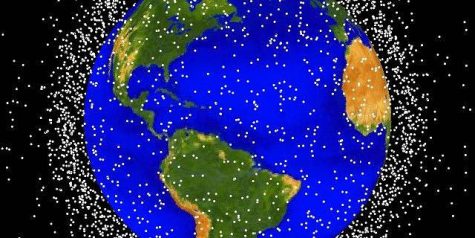There’s No More Space for Trash
April 15, 2019

What do outer space and the world’s oceans have in common? They’re riddled with trash.
With the ever increasing awareness of environmental issues, one critical location is being overlooked: space. According to National Aeronautics and Space Administration (NASA), more than 500,000 pieces of debris are being tracked as they orbit around earth. Even small pieces of this “space junk” pose threats to both manned and unmanned spacecrafts and satellites as the debris can reach speeds of 17,500 mph.
The issue with “many millions of pieces of debris [is] that [they] are so small they can’t be tracked,” according to NASA. Untrackable space junk, such as paint chips, have damaged many space shuttle windows that have needed to be replaced.
Another issue is the gap between what is trackable and what is shieldable. NASA can track debris that is 2 inches or larger and shield against debris that is .5 inches or smaller, but the 1.5 inch gap can cause a lot of damage to satellites and space crafts.
Jason Forshaw, a research fellow at the University of Surrey, is working on projects to clean up the junk with RemoveDebris. He believes the litter in space is becoming more of a risk for both current satellites and future launches.
There is so much space junk that NASA even admits it’s surprising how few disastrous collisions there have been. Cleaning up this debris has become necessary and a few plans of action have been proposed.
RemoveDebris is working with the University of Surrey to develop and test three ideas. The proposed methods, the net, the harpoon, and the sail, are aimed at bringing down broken or unusable satellites rather than smaller debris.
The net and harpoon will work together. One satellite will fire a net at the unusable craft inofer to create more drag and bring it down or pull it back to a spacecraft. The harpoon is instrumental in testing a satellite’s ability to hit another, which is a necessity for the net to work.
RemoveDebris’s third idea, the sail, would attach a sail like parachute to damaged crafts. This parachute, when deployed, would increase the drag thus bringing the satellite down.
But RemoveDebris is not the only idea. Companies like e.Deorbit and the Japanese Aerospace Exploration Agency (JAXA) Kounotori Integrated Tether Experiments are aiming to bring down satellites as well.
e.Deorbit is considering building a robotic arm or a net to bring down these satellites. Their specific aim is to grab the ENVISAT, an eight ton remote monitoring satellite.
JAXA wants to use the earth’s magnetic field to bring down satellites. Their project aims to run an electric current through unusable satellites. This current will result in the generation of a small magnetic field which will interact with the earth’s magnetic field thus pulling the satellite down.
While many unique ideas are in progress, there are also many obstacles to getting rid of this debris. One major issue is salvage laws. According to Brian Weeden of the Secure World Foundation, unlike our oceans where any person can salvage another’s ship, no such laws exist for space so the launching country jurisdiction and control over their space junk. This not only includes satellites and working vessels but also the paint chips and small debris that are one of the major concerns.
Likewise, the launching country also has liability for their devices. Proving who is at fault, especially in space, can be time consuming and costly. Any interaction with space junk that is not done by the launching country can cause major backlash because if anything happens because of the junk the launching country can be held liable.
All in all, cleaning up the junk in space will be a difficult task. With liability issues and the gap between trackable debris and shieldable debris, the job of cleaning up our litter will be difficult, but now, according to Forshaw, at least people are “actually [funding] missions to study and deal with it.”







